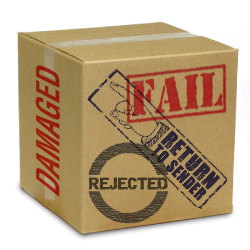The arrival of Labor Day cues ecommerce stores to ramp up for the holidays, and part of that means bracing for returns.
This is the sad story of a rejected product disgraced by its disillusioned owner and told to go back from whence it came. It’s the story of a returned order, and it’s likely to be horribly familiar to a merchant this holiday season as orders start bombarding stores. Not only are returns irritating for the devastated customer, they’re even more so for the merchant who now has to stop at the fulfillment finish line and potentially repeat the entire process with additional care to keep the customer coming back.
There have been reports that nearly a third of packages destined to satisfy their buyers end up being returned during the holidays. But don’t feel too bad. Returns are a part of any business, and it isn’t like you’re selling puppies that will inevitably be returned to the animal shelter after the magic of the season has passed. Fortunately, there are some ways to reduce the inevitable influx in returns.
Prevention
Smokey the Bear – cruelly named after the fire-savaged forest made him an orphan – said it best: “only you can prevent returns.” It’s important that merchants’ product marketing is the complete opposite of the bear’s first name. Product marketing on your site must be as clear as the blue sky in order to manage customer expectations, but it should also encourage them to break out their wallets. Make sure that descriptions strike the perfect balance of “amazingly realistic” – the product information should be short and sweet, believable, yet interesting enough to excite the customer as they click ‘add to cart.’
“Amazingly realistic” also goes for your product images. We all know fake or overdone when we see it. Even if the phenomenal picture of your product is the real deal, if the customer doesn’t believe it, it doesn’t matter. You aren’t getting a sale. If you’re also in an industry with a catalog of products in various sizes, make a point of emphasizing that the customer has selected a particularly size, whether as they add it to the cart, or when they’re reviewing it at checkout. Choosing the wrong size of a product is a major cause for returns, especially in apparel.
When It Happens
But on to how best remedy the problem of a return once it happens. Forget about figuring out why it occurred to start with; at this point, it’s about salvaging any relationship you had (or can have) with the customer. And a surefire way of making you and your significant customer feel slightly better after your mutual disappointment is by having a returns policy that establishes how you both proceed.
A returns policy, unlike most other policies (especially national ones), needs to be as concise as the product marketing mentioned above. Make it straightforwardly lay out what the customer should do and expect post-purchase. Below are some general guidelines for developing an efficient returns policy:
Use plain old English at an 8th grader’s reading level (or less) — Assume your site’s visitors have incredibly basic reading skills. It isn’t because your customer is unintelligent. It’s because not everyone is as smart as you.
Be to the point — Also assume your customers have itty bitty attention spans. You’ve likely seen some bounce rates (just like us) that pretty much reinforce this idea.
Throw the refund policy in their face — Make it very apparent that you have a returns policy if possible, whether its a bolded link, a pop up at the checkout page, or a printed slip placed in each order’s package.
Stay away from “you must do this” — Always, always avoid the words “you,” or any variation of “you have to” when communicating to your beloved customer. It’s very important to be as non-threatening as possible. They are emotionally damaged, potentially like the product that’s being returned, so be very careful to tiptoe around accusatory and demanding language, regardless of who is at fault.
Provide next steps — This is the bulk of your policy. It’s essential that you are clear-cut and unmistakable to keep your customer in order and on good terms. Next steps are very important, so clarify what the customer needs to do with the failed order. It’s important to define the following:
- How packaging will be dealt with – should you offer the packaging or does the customer need to get their own
- Where does the order need to be sent back to – depending on your fulfillment strategy, should it be sent to your HQ or a warehouse
- What should be included with the return – proof of purchase or an order slip, potentially a picture of the product upon arrival, or some feedback
- When should the return be sent by – select a reasonable timeframe forcing the customer to quickly send it back so the dispute is quickly closed
- Who is paying for shipping – is it worth it to cover the cost to keep a customer content (use your best judgement)
If you’re interested in seeing how to squeeze that lemon of a return into sweet revenue lemonade, check out our post here.



